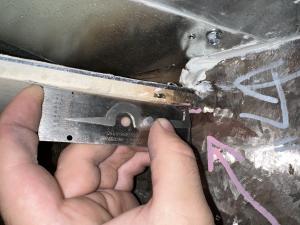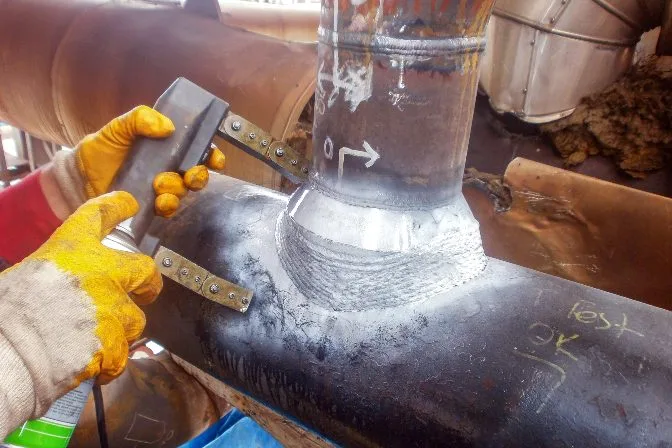Why You Need Expert Welding Inspection Racine for Your Jobs
Why You Need Expert Welding Inspection Racine for Your Jobs
Blog Article
Innovative Approaches to Fillet Weld Evaluation and Testing: Enhancing Weld High Quality and Compliance Criteria
In the world of welding, the quality and integrity of fillet welds play a vital function in guaranteeing the structural soundness and reliability of various commercial parts. With the constant drive for improved performance and conformity with rigid requirements, the exploration of innovative approaches to fillet weld inspection and screening has come to be important. As sectors advance, the standard techniques might no longer suffice in meeting the demands of modern-day welding applications. By welcoming sophisticated modern technologies and methods, a new perspective of opportunities emerges in the world of weld high quality assessment and adherence to conformity requirements.
Advanced Non-Destructive Screening Methods
Using state-of-the-art modern technologies, advanced non-destructive testing approaches play an important duty in making sure the integrity and high quality of fillet welds. These approaches, such as phased range ultrasonic screening (PAUT) and magnetic particle testing (MPT), deal detailed insights right into the weld's internal structure without creating any damage to the product. PAUT, as an example, utilizes several ultrasonic aspects to evaluate the weld from various angles, supplying a comprehensive visualization of prospective flaws like absence of fusion or splits.
Similarly, MPT is efficient in detecting surface-breaking problems by using an electromagnetic field and iron particles to the weld area. This technique is specifically valuable for identifying gaps that might jeopardize the weld's toughness. By using these innovative non-destructive testing techniques, weld inspectors can accurately evaluate the high quality of fillet welds, making sure conformity with market requirements and regulations. The capability to discover problems early not just improves weld high quality however likewise avoids expensive rework or failings in architectural stability, highlighting the importance of these ingenious testing approaches in welding inspections.
Robotics and Automation in Assessment
The assimilation of robotics and automation has revolutionized the examination procedure for fillet welds, enhancing performance and accuracy in top quality assessment. Robotics offer exact control and repeatability in examining welds, ensuring constant and dependable outcomes. Automated systems can be configured to adhere to specific assessment paths, making sure comprehensive insurance coverage of welds and reducing the danger of human mistake.
Robotic examination systems equipped with advanced sensors can detect and determine weld attributes with high precision, supplying detailed data for evaluation. These systems can recognize problems such as cracks, lack of combination, and porosity, making it possible for prompt restorative activities to be taken. In addition, robotics and automation permit real-time data collection and evaluation, giving prompt feedback to operators and assisting in fast decision-making processes.
Additionally, the use of robotics and automation in fillet weld examination boosts overall productivity by minimizing inspection times and boosting inspection throughput. By improving the evaluation process, makers can make certain weld top quality and conformity requirements are fulfilled efficiently, ultimately leading to cost savings and boosted item top quality.
Making Use Of Expert System for Evaluation
Fabricated knowledge plays a crucial duty in boosting the effectiveness and precision of analysis in fillet weld evaluation processes. By harnessing the power of AI, examiners can enhance the analysis of weld high quality and compliance criteria, bring about extra specific and trustworthy results. AI formulas can quickly process vast quantities of information from weld assessments, discovering problems or inconsistencies that might be testing to understand the naked eye. This advanced modern technology makes it possible for real-time tracking of weld quality, permitting for instant corrective activities to be taken if any concerns are discovered.
Additionally, AI systems can find out from past assessment information, constantly enhancing their capacity to identify potential problems and variances in fillet welds. This flexible learning capability enhances the overall quality control process, decreasing the possibility of human error and guaranteeing that welds satisfy the called for standards. By incorporating artificial intelligence into fillet weld analysis, markets can accomplish greater degrees of performance, uniformity, and compliance in their evaluation methods.
Portable Equipment for On-Site Assessment
 Enhancing area examination efficiency, the adoption of portable tools changes on-site analysis procedures for fillet welds. These devices offer versatility and comfort, permitting assessors to carry out extensive exams from this source in various places, including remote or difficult atmospheres. Portable tools such as ultrasonic testing devices, magnetic particle evaluation tools, and electronic radiography systems provide real-time data and high-resolution imaging capabilities, making it possible for fast decision-making and prompt responses on weld high quality.
Enhancing area examination efficiency, the adoption of portable tools changes on-site analysis procedures for fillet welds. These devices offer versatility and comfort, permitting assessors to carry out extensive exams from this source in various places, including remote or difficult atmospheres. Portable tools such as ultrasonic testing devices, magnetic particle evaluation tools, and electronic radiography systems provide real-time data and high-resolution imaging capabilities, making it possible for fast decision-making and prompt responses on weld high quality.One considerable advantage of portable devices is their capacity to simplify examination treatments, minimizing downtime and improving general productivity. Inspectors can conveniently move these devices to different job sites, removing the requirement for delivering heavy machinery or parts to off-site centers. Additionally, the transportability of these devices promotes cost-effectiveness by decreasing transport expenses and accelerating examination timelines.
In addition, the usage of portable devices for on-site evaluation advertises positive quality control actions, as examiners can promptly recognize and deal with any kind of prospective welding defects or disparities. By integrating these innovative innovations into on-site assessment practices, welding specialists can ensure conformity with industry requirements and enhance weld high quality, ultimately bring about improved architectural integrity and security in numerous welding applications.
Combination of Information Management Solution
Having actually optimized on-site assessment procedures through the application of portable tools, the straight from the source following stage involves the seamless combination of information management systems to even more boost performance and data analysis capacities in fillet weld assessment and testing. Welding Inspection Racine. By integrating data administration systems right into the inspection process, organizations can enhance information collection, storage space, and analysis. This combination permits real-time surveillance of weld quality, immediate identification of problems, and timely decision-making to remedy any kind of concerns that might arise great site during the evaluation process
Information administration systems play an essential function in streamlining assessment information, promoting very easy accessibility for accredited employees, and making certain information honesty and safety. Via the integration of these systems, assessors can produce detailed reports, track historical information for trend analysis, and enhance total process performance. The assimilation of data management systems makes it possible for smooth communication in between various stakeholders included in the evaluation process, cultivating partnership and enhancing total high quality control measures. Inevitably, the combination of data monitoring systems serves to boost the requirements of fillet weld examination and screening, ensuring conformity with industry guidelines and improving weld quality.
Final Thought
In verdict, innovative techniques to fillet weld inspection and testing have actually considerably boosted weld quality and compliance requirements. Advanced non-destructive screening methods, robotics, automation, expert system, mobile devices, and data management systems have changed the method weld examinations are conducted. By utilizing these innovations, markets can make certain that welds fulfill the required high quality requirements and guidelines, inevitably boosting overall efficiency and safety and security in welding procedures.

By utilizing these sophisticated non-destructive testing methods, weld examiners can accurately examine the high quality of fillet welds, making sure conformity with market requirements and laws. Portable tools such as ultrasonic testing tools, magnetic particle assessment equipment, and electronic radiography systems provide real-time data and high-resolution imaging capabilities, enabling fast decision-making and prompt feedback on weld quality.
Having actually maximized on-site assessment processes through the utilization of mobile tools, the next stage includes the seamless integration of information administration systems to even more improve efficiency and information evaluation abilities in fillet weld evaluation and screening (Welding Inspection Racine). Ultimately, the combination of data monitoring systems serves to boost the requirements of fillet weld inspection and screening, making sure compliance with sector policies and boosting weld high quality
 In verdict, ingenious approaches to fillet weld examination and screening have actually dramatically improved weld quality and conformity requirements.
In verdict, ingenious approaches to fillet weld examination and screening have actually dramatically improved weld quality and conformity requirements.Report this page